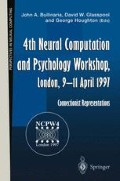Abstract
Topographic mappings are important in several contexts, including data visualization, connectionist representation, and cortical structure. Many different ways of quantifying the degree of topography of a mapping have been proposed. In order to investigate the consequences of the varying assumptions that these different approaches embody, we have optimized the mapping with respect to a number of different measures for a very simple problem — the mapping from a square to a line. The principal results are that (1) different objective functions can produce very different maps, (2) only a small number of these functions produce mappings which match common intuitions as to what a topographic mapping “should” actually look like for this problem, (3) the objective functions can be put into certain broad categories based on the overall form of the maps, and (4) certain categories of objective functions may be more appropriate for particular types of problem than other categories.
Access this chapter
Tax calculation will be finalised at checkout
Purchases are for personal use only
Preview
Unable to display preview. Download preview PDF.
References
Barlow, H.B. (1989). Unsupervised learning. Neural Computation, 1, 295–311.
Bezdek, J.C. and Pal, N.R. (1995). An index of topological preservation for feature extraction. Pattern Recognition, 28, 381–391.
Cowey, A. (1979). Cortical maps and visual perception. Qua. Jou. Exper. Psychol., 31, 1–17.
Durbin, R. and Mitchison, G. (1990). A dimension reduction framework for understanding cortical maps. Nature, 343, 644–647.
Goodhill, G. J., Finch, S. and Sejnowski, T. J. (1995). Quantifying neighbourhood preservation in topographic mappings. Institute for Neural Computation Technical Report Series, No. INC-9505, November 1995. Available from http://www.giccs.georgetown.edu/—geoff
Goodhill, G.J. and Sejnowski, T.J. (1996) Quantifying neighbourhood preservation in topographic mappings. In: “Proceedings of the 3rd Joint Symposium on Neural Computation”, University of California, San Diego and California Institute of Technology, Vol. 6, Pasadena, CA: California Institute of Technology, 61–82. Available from http://www.giccs.georgetown.edu/ —geoff
Goodhill, G.J. and Sejnowski, T.J. (1997). A unifying objective function for topographic mappings. Neural Computation, 9, 1291–1304.
Hubel, D.H. and Wiesel, T.N. (1977). Functional architecture of the macaque monkey visual cortex. Proc. R. Soc. Lond. B 198 1-59.
Kirkpatrick, S., Gelatt, C.D. and Vecchi, M.P. (1983). Optimization by simulated annealing. Science, 220, 671–680.
Kohonen, T. (1982). Self-organized formation of topologically correct feature maps. Biol. Cybern., 43, 59–69.
Krzanowski, W.J. (1988). Principles of multivariate analysis: a user’s perspective. Oxford statistical science series; v. 3. Oxford University Press.
van Laarhoven, P.J.M. and Aarts, E.H.L. (1987). Simulated annealing: theory and applications. Reidel, Dordrecht, Holland.
Luttrell, S.P. (1990). Derivation of a class of training algorithms. IEEE Trans. Neural Networks, 1, 229–232.
Mitchison, G. (1991). Neuronal branching patterns and the economy of cortical wiring. Proc. Roy. Soc. B., 245, 151–158.
Mitchison, G. (1995). A type of duality between self-organizing maps and minimal wiring. Neural Computation, 7, 25–35.
Nelson, M.E. and Bower, J.M. (1990). Brain maps and parallel computers. Trends Neurosci, 13, 403–408.
Sammon, J.W. (1969). A nonlinear mapping for data structure analysis. IEEE Trans. Comput., 18, 401–409.
Shepard, R.N. (1980). Multidimensional scaling, tree-fitting and clustering. Science, 210, 390–398.
Torgerson, W.S. (1952). Multidimensional Scaling, I: theory and method. Psychometrika, 17, 401–419.
Udin, S.B. and Fawcett, J.W. (1988). Formation of topographic maps. Ann. Rev. Neurosci., 11, 289–327.
Author information
Authors and Affiliations
Editor information
Editors and Affiliations
Rights and permissions
Copyright information
© 1998 Springer-Verlag London Limited
About this paper
Cite this paper
Goodhill, G.J., Sejnowski, T.J. (1998). Objective Functions for Topography: A Comparison of Optimal Maps. In: Bullinaria, J.A., Glasspool, D.W., Houghton, G. (eds) 4th Neural Computation and Psychology Workshop, London, 9–11 April 1997. Perspectives in Neural Computing. Springer, London. https://doi.org/10.1007/978-1-4471-1546-5_7
Download citation
DOI: https://doi.org/10.1007/978-1-4471-1546-5_7
Publisher Name: Springer, London
Print ISBN: 978-3-540-76208-9
Online ISBN: 978-1-4471-1546-5
eBook Packages: Springer Book Archive

